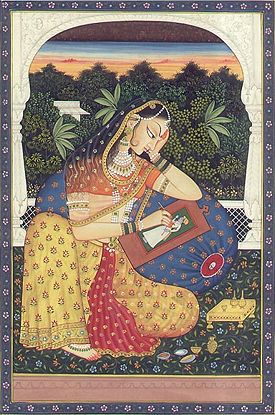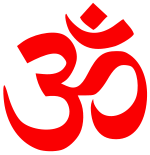Radha
| Radha | |
 A Rajastani style painting of Radha |
|
| Devanagari | राधा |
|---|---|
| Abode | Vrindavan |
| Mantra | Aum Vrashbhanujaye Vidmahe/ Krishnapriyaye Dheemahi/Tanno Radha Prachodayat |
| Weapon | None |
| Consort | Krishna |
Radha (Devanagari: राधा, IAST: Rādhā) is the principal consort of Krishna in the Srimad Bhagavatam, and the Gita Govinda of the Hindu religion. Krishna.[1] Radha is almost always depicted alongside Krishna and features prominently within the theology of today's Gaudiya Vaishnava religion, which regards Radha as the original Goddess or Shakti. Radha's relationship with Krishna is given in further detail within texts such as the Brahma Vaivarta Purana, Garga Samhita and Brihad Gautamiya tantra. Radha is also the principal object of worship in the Nimbarka Sampradaya, as Nimbarka, the founder of the tradition, declared that Radha and Krishna together constitute the absolute truth.[2]
Radha is often referred to as Radharani in speech, prefixed with the respectful term 'Srimati' by devout followers.
Contents |
Radha the Gopi
In the story of Krishna, as told in the Mahabharata and the Bhagavata Purana, he spends much of his youth in the company of young cow-herd girls, called Gopis in the village of Vrindavan. The Mahabharata does not describe Krishna's earlier life in Vrindavan in much detail, and focuses more on the later battle of Kurukshetra but within the Bhagavata Purana the child-hood pastimes of Krishna are described very vividly. Within the Bhagavata Purana, Radha is not mentioned by name but is alluded to within the tenth chapter of the text as one of the gopis who Krishna plays with during his upbringing as a young boy. Krishna left Brindavan for Mathura at the age of 10 years and 7 months according to Srimad Bhagavatam.[3] So Radha is assumed to be also 10 years old or less when Krishna left Brindavan. It is in later texts such as the Gita Govinda where we find the story of Radha given in more detail.
- See also: Radha Krishna

In the Vaishnava devotional or bhakti traditions of Hinduism that focus on Krishna, Radha is Krishna's consort. For some of the adherents of these traditions, her importance approaches or even exceeds that of Krishna. She is considered to be his original shakti, the supreme goddess in both the Nimbarka Sampradaya and following the advent of Chaitanya Mahaprabhu also within the Gaudiya Vaishnava tradition. Other gopis are usually considered to be her maidservants, with Radha having the prominent position of Krishna's favour.
Her connection to Krishna is of two types: svakiya-rasa (married relationship) and parakiya-rasa (a relationship signified with eternal love).
In the Nimbarka Sampradaya, Radha's relationship with Krishna is characterised by the svakiya-rasa, based on texts in the Brahma Vaivarta Purana and the Garga Samhita describing the wedding of Radha and Krishna. The Gaudiya tradition focuses upon parakiya-rasa as the highest form of love, wherein Radha and Krishna share loving exchanges through separation. The love the gopis feel for Krishna is also described in this esoteric manner as the highest platform of spontaneous love of God, and not of a mundane sexual nature. Proponents of the Gaudiya and Nimbarka schools of Vaishnavism give the highly esoteric nature of Radha's relationship to Krishna as the reason why her story is not mentioned in detail in the other Puranic texts.
Birth
Vaishnava tradition states that Radha was born in either Varshana, or Rawal, a village about 8 kilometers from Vrindavan, near present day New Delhi in India.[4] There are a number of accounts of her parentage. Her father was the king of cowherds called Vrsabhanu. Vrsabhanu was a partial incarnation of Lord Narayana while her mother Kalavati was a partial incarnation of Goddess Lakshmi.
Her worship is especially prominent in Vrindavan, the place where Krishna is said to have lived over 5000 years ago. Wherein Her importance surpasses even the importance of Krishna. Radha's love for Krishna is held within Gaudiya Vaishnavism as the most perfect primarily because of its endless and unconditional nature. Thus she is the most important consort of Krishna, 'His heart and soul', and His 'hladini-shakti' (spiritual pleasure potency).
In the Brihad-Gautamiya Tantra, Radharani is described as follows: "The transcendental goddess Srimati Radharani is the direct counterpart of Lord Sri Krishna. She is the central figure for all the goddesses of fortune. She possesses all the attractiveness to attract the all-attractive Personality of Godhead. She is the primeval internal potency of the Lord."
Nimbarka
Nimbarka was the first Vaishnava acharya to disseminate teachings about Radha.[5][6]
Chaitanya Mahaprabhu
The Bengali saint Chaitanya Mahaprabhu (1486 - 1534) is believed by many (see especially the modern-day ISKCON movement) to be an incarnation of both Radha and Krishna, simultaneously in one form. Throughout his life, Chaitanya lived as a devotee of Vaishnava tradition, not openly claiming to be any form of avatar, but in his biographies it is claimed that he revealed his divine form to some of his closer associates.[7]
Festivals
Radha's birthday is celebrated as Radhastami.During this time devotees are allowed special sanctions not normally allowed. For example, Radha's name is normally not chanted due to the possibility of committing offenses towards her. Neither are all devotees qualified to enter into her kunda, or lake, which is considered holy. On the festival day of the appearance of Radha Kunda (Radharani's lake), devotees wait up until midnight in order to bathe there. And there is much recitation of her holy names on her "appearance day" or "birthday". She is said to "appear" because she does not take birth or die, being an eternal associate of Krishna, both of whom are liberated. She is the most chaste woman, "married" to Krishna.
The foremost of the Gopis
The Padma Purana describes 18,000 cowherd-girls (gopis) among whom it says 108 are the most important. Among those 108, eight are considered more important still, and among the eight, two have a special position - Chandravali and Radharani. Of the two, Radha is considered the foremost.
Names & Worship

Radha has many epithets describing her qualities and characteristics.
- Gandharvi - expert singer[8]
- Govinda-nandini - She who gives pleasure to Govinda (Krishna)
- Govinda-mohini - She who mystifies Govinda
- Govinda-sarvasva - the all-in-all of Govinda
- Sarva-kanta Shiromani - the crown jewel of all Krishna's consorts
- Krishnamayi - the one who sees Krishna both within and without
- Radhika - Her worship of the Krishna consists of fulfilling His desires
- Madan-Mohan-Mohini - Within Gaudiya tradition Krishna (as the Supreme Person) is believed to be the enchanter of all living beings, including even Kamadeva (Madan) - the god of attraction. Because Radha has the unique position of being able to enchant even Krishna she is therefore known as Madan-Mohan-Mohini: the enchanter of the enchanter of Cupid.
- Aradhana - The root name of Radharani, meaning one who excels in worshiping Krishna
- Sarva-lakshmi - The original source of all the goddesses of fortune
- Vrshabhanu-nandini - daughter of Vrishabanu
- Vrndavaneshvari - Queen of Vrindavana
- Lalita-Sakhi - friend of the gopi Lalita
- Gokula-Taruni - She whom all young girls of Gokul worship
- Damodara Rati - She who dresses herself to please Damodara (Krishna)
- Radharani – Radha the queen
- RadhaKrishna - Worship of Krishna with Radha
One of her names, Hara (mentioned in Narada-pancaratra 5.5.59), in vocative Hare, forms a part of the Hare Krishna 'Maha-Mantra', one of the most popular Vedic mantras, especially amongst Gaudiya Vaishnavas. Radharani's names hold a place of prime importance within Gaudiya Vaishnava religious practices.
Temples dedicated to Radha
- Barsana and Vrindavan in Mathura District, Northern India contain a large number of temples dedicated to both Radha and Krishna, including the Radhavallabh Temple. [9]
- Barsana Dham in Austin, Texas, USA, one of the largest Hindu temples in the western Hemisphere.[10]
Temple Deities in India and abroad are generally named in order of Radharani first and then Krishna. Krishna is approachable through the mercy of Srimati Radharani and no one else. So for example, if one were to enter the Govindaji temple in Vrindavan the Deities are named Radha Govinda and devotees of Krishna would pray to Radha and Govinda not just Krishna. This is because Krishna is controlled by Radharani's love.
Quotations about Radha
- "Although the effulgence of the moon is brilliant initially at night, in the daytime it fades away. Similarly, although the lotus is beautiful during the daytime, at night it closes. But, O My friend, the face of My most dear Srimati Radharani is always bright and beautiful, both day and night. Therefore, to what can Her face be compared?" (Vidagdha-madhava 5.20)
- "When Srimati Radharani smiles, waves of joy overtake Her cheeks, and Her arched eyebrows dance like the bow of Cupid. Her glance is so enchanting that it is like a dancing bumblebee, moving unsteadily due to intoxication. That bee has bitten the whorl of My heart." (Vidagdha-madhava 2.51)
- "Just as Srimati Radharani is most dear to Krishna, Her bathing pond is similarly dear. Of all the gopis, She is the most beloved of the Lord." (Padma Purana)
- "The transcendental goddess Srimati Radharani is the direct counterpart of Lord Sri Krishna. She is the central figure for all the goddesses of fortune. She possesses all attractiveness to attract the all-attractive Personality of Godhead. She is the primeval internal potency of the Lord." (Brihad-gautamiya-tantra)
- "Among all persons, it is Sri Radha in whose company Lord Madhava is especially glorious, as She is especially glorious in His." (Rig-parisishta)
- "Radharani is the source of spiritual inspiration" (A.C. Bhaktivedanta Swami Prabhupada)
Husband of Radha
In a number of versions of her story, although Radha's first love is Krishna (whom she knows through her childhood) she is later forced to marry Abhimanyu, the son of Jatila. One source for this information is Sri Sri Camatkara Candrika by Srila Visvanatha Cakravarti Thakura. Other traditions give the name of the husband of Radha as 'Chandrasena'
See also
- Hare Krishna
- Lakshmi
- Sita
- Shakti
- Shri Hith Harivansh Mahaprabhu
- Chaitanya Mahaprabhu
- Nimbarka Sampradaya
- Gaudiya Vaishnavism
- Mantra
Further reading
- Krsna: The Supreme Personality of Godhead (ISBN 0-89213-354-6) by A.C. Bhaktivedanta Swami Prabhupada
- Hindu Goddesses: Vision of the Divine Feminine in the Hindu Religious Traditions (ISBN 81-208-0379-5) by David Kinsley
- Hawley J.S. & D.M. Wulff (ed.) (1986) The Divine Consort: Radha and the Goddesses of India, Beacon Press, Boston, ISBN 0-8070-1303-X.
Footnotes
- ↑ Beck, Guy L. (2005). Alternative Krishnas: regional and vernacular variations on a Hindu deity. Albany, N.Y: State University of New York Press. pp. p. 68. ISBN 0-7914-6415-6.
- ↑ H.Wilson, Brahmavaivarta Purana with English Translation]], Motilal Banarsidas Publishers, 1990 reprint.
- ↑ http://www.vedabase.net/sb/10/45/3/en
- ↑ Bimanbehari Majumdar (1969). Kṛṣṇa in History and Legend. India: University of Calcutta. pp. 307.pp.85-86
- ↑ Singh, K.B. (2004). "Manipur Vaishnavism: A Sociological Interpretat1on". Sociology of Religion in India. http://books.google.com/books?hl=en&lr=&ie=UTF-8&id=2cIOqGcvHqoC&oi=fnd&pg=PA125&dq=Nimbarka+Radha+first&ots=-y8T8YWEQr&sig=DILJQAFDN4c9WGtNY-z0khzONYk. Retrieved on 2008-05-03.
- ↑ Kinsley, D. (1972). "Without Krsna There Is No Song". History of Religions 12 (2): 149. doi:. http://books.google.com/books?hl=en&lr=&ie=UTF-8&sa=G&oi=qs&q=nimbarka+radha+first+author:d-sarma. Retrieved on 2008-05-03."Nimbarka seems to have been the first well-known religious leader to regard Radha as central to his cult (thirteenth century)"
- ↑ Chaitanya Charitamrita Madhya-lila 8.282
- ↑ Gopala Tapani Upanishad 2.12,28,118
- ↑ Radhavallabh Temple
- ↑ University Newsletter
External links
General Information
- Sri Radha Sakhi Homepage
- Krishna.com: Who Is that Girl with Krishna?
- Sri Radha in detail
- Sri Radha the supreme power Radhavallabh Homepage
- Srimati Radharani - Personality
- Sri Radha's detailed supreme existence
Festivals
- Celebrating Radhastami
- Srimati Radharani's Appearance
- Radhashtami the festival of delight
- Radhashtami Celebration in Vrindavan
Names of Radha
- Sri Radha's name in Srimad Bhagavatam
- The Names of Srimati Radharani
- Sri Radha rani's 100 essence filled divine names.
Further resources
- Krsna and Radha, Goloka - references
- Zipped Downloadable Information
- "Srila Prabhupada’s Presentation of Srimati Radharani".
|
|||||||||||||||||
|
|||||||||||||||||

